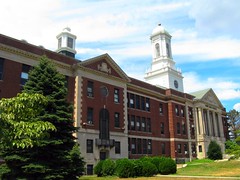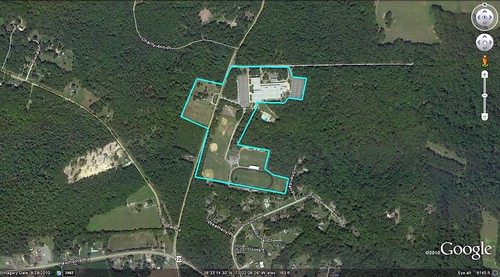Will EPA's guidelines help communities build walkable schools?

Posted October 18, 2011 at 1:32PM
Today's post is guest-written by my friend and frequent collaborator, Lee Epstein. Lee is an attorney and land use planner working in the mid-Atlantic region.
As some of my colleagues know by now, I view high quality public education as a crucial component in promoting sustainable urban communities and smart growth. Unless or until public education in cities and towns is equivalent to – or better than -- that obtainable in the suburbs, it will be very difficult to retain or attract young, middle class families with kids. These families are, or can be, the social heart and economic soul of such a community. Fortunately, the school reform taking place in some urban centers today may move us closer to that goal in the not too distant future.
Having said that, I’m obviously not the first to note that another public education issue is of equal relevance to smart, sustainable growth, especially in rapidly urbanizing suburbs: the location of new schools. My good friend Constance Beaumont wrote one of the first pieces on this back in 2002 for the National Trust for Historic Preservation, Why Johnny Can’t Walk to School, and another friend, Sam Passmore, wrote Education and Smart Growth that same year for the Charles Stewart Mott Foundation – and lots has gone on in the field since then. Indeed, this very blog has covered some of these issues for many years (e.g. “Biking, Walking to School Illegal in Saratoga Springs,” “Great principles for smart growth schools”).
In 2011, then, it is extraordinarily vexing to read or hear about yet another new, purportedly “green school” being built on a huge site isolated on a cleared farm field at the very edge – or even five or ten miles from -- the community it is actually serving. The building itself may be as green as County Kerry, but the location makes it as brown as the mud on the former farmer’s work boots.
Can school children of any age safely walk or bike to such a facility? Can faculty or administrators? How much carbon and nitrogen-spewing car and bus exhaust, and gasoline, does it take to deliver students daily to such a school? Is the plowing under of local farm fields or woodlots, and its replacement with artificial turf football and soccer fields, and acres of parking lots, “green?”
Can such a school become the true center of a community, where kids stay or go to after-school programs, where “English as a Second Language” classes are held two or three days per week, where the gym,  assembly room, cafeteria, or library is available for community meetings, fairs, and even church on Sunday, and where athletic events are easy for hard-working parents to attend? Is it possible that developers in the region will view the new school’s location as a foot in the door, a necessary precursor for new residential development, even farther out, and that the community will eventually go along? This, unfortunately, is just another “sprawl school,” not a “green” one. (Of course, the situation in entirely rural communities with very small central towns may be different.)
assembly room, cafeteria, or library is available for community meetings, fairs, and even church on Sunday, and where athletic events are easy for hard-working parents to attend? Is it possible that developers in the region will view the new school’s location as a foot in the door, a necessary precursor for new residential development, even farther out, and that the community will eventually go along? This, unfortunately, is just another “sprawl school,” not a “green” one. (Of course, the situation in entirely rural communities with very small central towns may be different.)
Fortunately, reform is happening. Encouragingly, EPA has fully recognized the direct and indirect environmental consequences of poor school siting decisions, and has recommended that school systems recognize such issues as well. In a recently published set of (voluntary) school siting guidelines, the agency encourages school systems to undertake an environmental review of any new facilities they wish to construct, and to consider the location of such schools as an important component in the evaluation.
In other progress, school construction “standards” published by professional associations such as the Council of Education Facility Planners International, no longer state unequivocally that a new high school “needs” 30-40 acres and a middle school 10-20 acres; CEFPI has worked with U.S. EPA in recent years to examine and redefine such needs and desires. There are, for example, ways for schools near one another to double up on athletic and practice fields, use in-town community parks for some of these purposes, or just locate only their playing fields where enough space may be found for them. From an environmental, community, and sometimes historic preservation perspective, often the best outcome for all is the renovation of existing facilities, or the reconstruction of a new school in the midst of a community.
30-40 acres and a middle school 10-20 acres; CEFPI has worked with U.S. EPA in recent years to examine and redefine such needs and desires. There are, for example, ways for schools near one another to double up on athletic and practice fields, use in-town community parks for some of these purposes, or just locate only their playing fields where enough space may be found for them. From an environmental, community, and sometimes historic preservation perspective, often the best outcome for all is the renovation of existing facilities, or the reconstruction of a new school in the midst of a community.
The same might not necessarily be said for all states and localities, however, many of which may still be mired in old thinking. Some may still prescribe minimum acreage for each type of school; proscribe multi-story facilities; not require new schools to be wired for distance learning; not mandate conformity with a community’s local comprehensive plan; and not require full, life-cycle and benefit-cost studies on proposed new facilities, that take into account the costs of transportation to serve the school, or the costs to convenience, and even the health costs to the community relative to childhood obesity issues.
Where the next shiny new high school goes in your town or county will affect sustainability, environment, and public health in the community for decades to come. Let’s hope the decision is made with smart growth in mind.
Move your cursor over the images for credit information.

